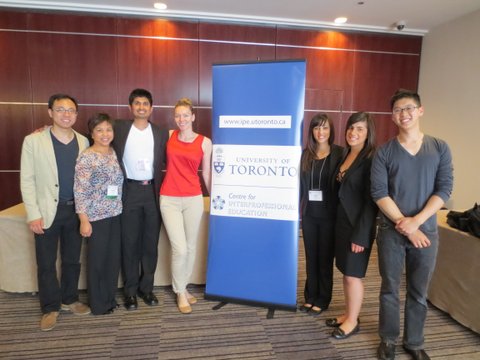(As appears in U of T News)
Demonstrating teamwork, collaboration and the need for policy change for patient care, students from U of T claimed top honours at the 2013 National Health Care Team Challenge (HCTC).
Students Elisa Simpson (Lawrence Bloomberg Faculty of Nursing), Christopher Siu and Keyur Shah (Leslie Dan Faculty of Pharmacy), Kaspar Ng (Faculty of Medicine) collaborated with Leigha Saunders (Canadian College of Naturopathic Medicine) and Patricia Galata (Canadian Memorial Chiropractic College). The team, working through the IPE curriculum coordinated by U of T’s Centre for Interprofessional Education (IPE), had to prepare and present a patient case study in front of a live audience.
Their case study – an Aboriginal man presenting with a foot infection and other chronic conditions – required the team to create a management plan providing optimum patient/client care.
“As a group we met with our faculty advisors to see how we could get an edge on the competition,” says Simpson. “We knew all of the teams would discuss straightforward approaches, like prescribing antibiotics, and we wondered how we could stand out.”
Mentors Zoraida DeCastro Beekhoo, a senior lecturer at Bloomberg Nursing, and Chadwick Chung, a faculty member at Canadian Memorial Chiropractic College, saw how easily the group bonded and responded to the question as one unit working together.
They encouraged the students to continue using their strengths to collaborate and build that trust.
The team incorporated a North American Aboriginal medicine wheel into the presentation – a move that showed respect for the patient’s beliefs, added a strong visual element, and provided structure. Team members dressed in the colour of one of the medicine wheel’s four healing elements: Shah in white for the physical aspect, Galata in red for the mental aspect, Saunders in black for the spiritual aspect and Simpson in yellow for the emotional aspect. They presented ideas based on the four aspects of the wheel, addressing the needs of the patient as a whole person, and as part of a community. At the end, the team and the patient joined hands to visualize the holistic benefits of the medicine wheel.
The teams were also given one hour on the day of the challenge to prepare an answer to an additional question addressing the patient/client situation six weeks after the initial visit, where the patient came back with complications and was unhappy with his care plan. Then the teams were given one minute to provide another solution to the same concerns. The repetition of questions indicated that while management plans were solid, there was more to this case than just physical symptoms.
“In that one minute to confer and present a viable solution to the patient’s concerns, our advocacy light bulbs came on and we knew that we would have to go beyond working resourcefully within the constraints of this case,” says Ng. “The patient did not show improvement with his symptoms, his trust in the health care team was low and this stemmed from the barriers to health care access on reserves – policy change would be vital in order to have a positive impact on patient care.”
With minimal time to prepare, and fully trusting each other’s judgment, the team spoke about the challenges the patient faced accessing the health care he needed. Location and resources made it difficult for him to follow the management plan and the team acknowledged that health care providers need to act as advocates for their patients or clients at the system and policy level so they can get equal care, as mandated by the Health Care Act. They were the only team to address these issues.
“As interprofessional education continues to have more of an impact, I’m seeing the next generation of our health care practitioners fully embrace this teamwork-based model of delivering health care,” says Susan Wagner, student mentor and initiator of the HCTC at U of T. “The Health Care Team Challenge provides meaningful learning opportunities for students and really fosters the skills and desire for teamwork in a practice setting.”
Started by the University of British Columbia (UBC) over 25 years ago, the HCTC grew from a local student event to a national one, developed by the National Health Sciences Students’ Association. The idea to harness interprofessional education at the student level, by bringing them together from different health care professions to work on a management plan for a clinical case has even gone global. Now students from around the world participate in their local HCTC, where on three separate occasions during the challenge they are given one week, one hour and one minute to present their recommendations for a complex case and showcase the future of health care teamwork.
The Canadian Challenge for 2013 also brought teams from Queen’s University, Western University, The UBC, The Michener Institute, the University of Ottawa, and the University of Alberta.
“U of T teaching the whole team, to look at the big picture, I feel that really gave us an edge when presenting our answers,” says Simpson.
“A world leader in IPE, the University of Toronto is reshaping the future of health care at the practice and policy level, through its curriculum and activities such as the HCTC,” says Wagner, who played a key role in developing curriculum for the IPE centre. “Our students are showcasing the impact of the IPE curriculum, but this even extends to our clinical partners where students can expand on what they’ve learned at the university into the workplace.”
